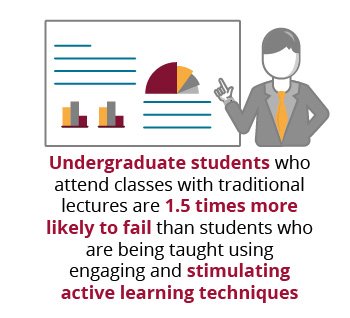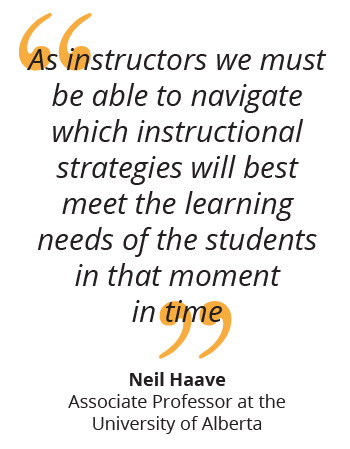Active Learning: the Future Of Higher Ed?
Undergraduate students who are being taught using engaging and stimulating active learning techniques are 1.5 times more likely to pass their classes than students who attend classes with traditional lectures.1
This is the astounding result revealed by a report in the Proceedings of the National Academy of Sciences, after analyzing 225 studies of undergraduate STEM teaching methods.
And although many may be happy to see proof that lecturing is outdated and inefficient, Noah Finkelstein, Director of the Center for STEM Learning at the University of Colorado still maintains the traditional lecture shouldn’t be cut out of the picture entirely:2
“I don’t think there should be a monolithic stance about lecture or no lecture. There are still times when lectures will be needed, but the traditional model of stand-and-deliver is being demonstrated as less effective at promoting student learning and preparing future teachers.”
However, Scott Freeman, one of the authors of the study, is adamant that “brilliant lectures” do not outperform an active learning approach to higher education teaching: “We’ve yet to see any evidence that celebrated lecturers can help students more than even first-generation active learning does.”

Active learning versus traditional lectures
In the higher education landscape, lecturing is definitely the most widely used method of teaching in universities all over the world, but increasingly researchers and educators are becoming activists of more engaging instructional strategies.
A variety of studies discussed in the March 2016 issue of The Teaching Professor newsletter, highlights the sustained frequency of lecturing in higher education.
275 Economics faculty surveyed reported they spend 70% of the time lecturing and 20% leading class discussions; and less than a third of Geoscience faculty surveyed use interactive techniques other than lecturing.3
However, as technological advances become more pervasive across various sectors, including universities, lecturers will need to ensure the content they teach is being heard, engaged with, and valued.
Perhaps the question is not “To lecture or not to lecture?”, but rather, “What is the best way to teach these students a particular skill?”. Perhaps there is a middle ground which more accurately reflects what is happening in the classroom.
Neil Haave, an associate professor at the University of Alberta, believes that faculty should not only be experts in their disciplinary orientation, but also experts in pedagogy. They should pay as much attention to how they teach as they do to what they teach.
“As instructors, we must be able to navigate which instructional strategies will best meet the learning needs of the students in that moment in time”, says Haave. “This may require an explanation from the teacher or an activity that engages the students – it depends on students’ learning needs in the moment.”4

How to use active learning to create an engaged classroom
The question faculty should be asking themselves is, “How can we make lectures more interactive and engaging while keeping them geared towards higher-level learning?”
With students’ attention being increasingly captured by social media, their need to constantly communicate via text, and the presence of an “always online” mindset, educators may struggle to keep them engaged by simply standing in front of a classroom, speaking to them.
Simply put, active learning is the process of learning through interacting with the content. This means students will be asked to participate in learning activities during class that keep them engaged with the learning material, and encourage them to think about the material they are studying rather than just transcribing notes from what a lecturer is saying.
The aim of this “lecturing of the future” is on skills development and higher-order thinking rather than just having the intent to convey information.
Bonwell and Eison, authors of Active Learning: Creating Excitement in the Classroom, describe active learning this way: “When using active learning, students are engaged in more activities than just listening. They are involved in dialogue, debate, writing, and problem-solving, as well as higher-order thinking, e.g., analysis, synthesis, evaluation.”5
But this is not to say that the lecture is entirely eliminated from the learning process. Rather, educators should focus on “lecturing” in small increments, where they can maintain student attention while giving the bulk of teaching time to active learning. This way academic rigor is maintained, but the classroom also becomes a more engaging and relevant learning environment.
Are you ready to transform your teaching career?
Gain the advantage by taking the Harvard Teaching and Learning Strategies for Higher Education online short course through GetSmarter.
1 Wired
2 Science Mag
3 Teaching Professor Conference Resource
4 Faculty Focus
5 Online Learning Insights